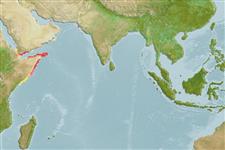>
Perciformes/Serranoidei (Groupers) >
Anthiadidae (Fairy basslets or Streamer basses)
Etymology: Plectranthias: Greek, plektron = anyhting to strike with, spur + Greek, anthias = a fish, Sparus aurata (Ref. 45335).
Environment: milieu / climate zone / depth range / distribution range
Ökologie
seewasser bathydemersal; tiefenbereich 190 - 290 m (Ref. 8944). Deep-water
Western Indian Ocean: Gulf of Aden, Socotra.
Size / Gewicht / Alter
Maturity: Lm ? range ? - ? cm
Max length : 8.9 cm SL Männchen/unbestimmt; (Ref. 8944)
Rückenflossenweichstrahlen (insgesamt) : 17. Head almost completely scaled. Preopercle: ventral margin with 2 antrorse spines; posterior margin coarsely serrated (ca 26 serrae). Ten oblique rows of cheek scales, between eye and preopercle corner.
Life cycle and mating behavior
Maturities | Fortpflanzung | Spawnings | Egg(s) | Fecundities | Larven
Randall, J.E., 1980. Revision of the fish genus Plectranthias (Serranidae: Anthiinae) with description of 13 new species. Micronesia 16(1):101-187. (Ref. 8944)
IUCN Rote Liste Status (Ref. 130435)
Bedrohung für Menschen
Harmless
Nutzung durch Menschen
Tools
Zusatzinformationen
Download XML
Internet Quellen
Estimates based on models
Preferred temperature (Ref.
123201): 12.9 - 18.5, mean 14.9 °C (based on 5 cells).
Phylogenetic diversity index (Ref.
82804): PD
50 = 0.5000 [Uniqueness, from 0.5 = low to 2.0 = high].
Trophic level (Ref.
69278): 3.8 ±0.6 se; based on size and trophs of closest relatives
Widerstandsfähigkeit (Ref.
120179): hoch, Verdopplung der Population dauert weniger als 15 Monate. (Preliminary K or Fecundity.).
Fishing Vulnerability (Ref.
59153): Low vulnerability (10 of 100).
